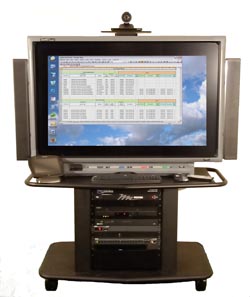Hyper Interactivity

Follow us
Add us as a preferred source on Google
- AVS' ReadyView Mobile systemInteractive whiteboards have been around for several years, but recently the product has been getting more attention as integrators are placing them into more systems. While the common preconception is that whiteboards are intended for the classroom, up until recently they've been appearing more often in meeting rooms. But now these products are finding their place at the head of the class.
- Julie Solomon, CCS Presentation Systems' training manager, noted the deployment of whiteboards in classrooms. "There are new statistics that state seven percent of schools in the U.S. have some kind of interactive whiteboard, so we're still pretty early in having interactive technology in the classroom," she said.
- While schools are still adopting electronic whiteboards slowly but steadily, they are now being integrated as part of a larger systems picture. Solomon explained, "Whiteboards are being integrated with other pieces of technology in the classroom. Document cameras are becoming more popular and are replacing the old overheads. Student response systems are also becoming very popular. So all of these devices, within their hardware and software, allow you to interact with the other devices in the room."
- Besides being able to speak to other devices, there are several newer features that are attracting new business. Allan Childers, marketing communications specialist for Audio Video Systems, expanded, "Overall, whiteboard technology and software allows for greater ability to manipulate content, documents, images, and presentations, while also adding in interactivity such as animation, audio, and video, all in an interactive capacity. Whiteboards provide the functionality of using applications such as Word, Excel, and PowerPoint as normal, but with annotation capability. Being able to save those annotations right within the applications, and then disseminate files in many ways such as email or posting on a website is another great feature."
- Besides schools, other markets are taking advantage of the newer features whiteboards are offering, Childers noted. "Companies and government offices can use whiteboards while web conferencing over the internet and collaborate on proposals, presentations, and brainstorm all in real-time. The military can provide in depth training/classes for soldiers, pilots, etc., giving them the ability to annotate in real-time during military exercises using maps, briefings, and distance collaboration."
- While whiteboards are packed with attractive features, there are issues that integrators are facing with the product, as Childers mentioned. "One of the issues for customers is portability. Whiteboards, mounted in a conference room or classroom, are great except for situations where they need to be used in multiple rooms. AVS is trying to meet customers' needs by providing a solution that provides portability of not only their whiteboard as part of a flat panel display, but also allows them to use their entire AV system, from DVD to computer to videoconferencing in a portable arrangement. AVS' ReadyView Mobile system is a fully integrated presentation cart system that incorporates a SMART overlay along with the flexibility to easily move an entire system from room-to-room."
- Another issue that is being addressed is user training. Solomon noted, "Teachers have a way of doing things, so when you introduce something new it can be a challenge. But they're finding that it makes their classroom much more exciting. We have a series of classes here at CCS, but within a few hours they're usually comfortable enough to use it."
- Childers added, "We find that over time, customers don't use the whiteboard as much, because they are not comfortable using it. AVS offers training programs for customers where we go in for either two-, four-, or eight-hour sessions and teach an organization's staff how to use and incorporate the whiteboard into their daily lives."
scn Newsletter
A daily selection of the top stories for AV integrators, resellers and consultants. Sign up below.
TOPICS
MORE FROM SCN
